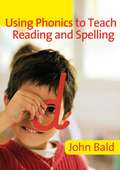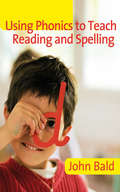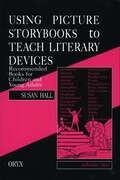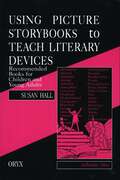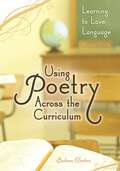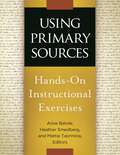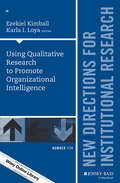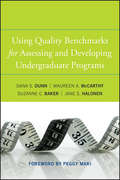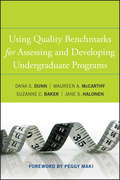- Table View
- List View
Using Peer Tutoring to Improve Reading Skills: A practical guide for teachers
by Keith Topping David Duran Hilde Van KeerUsing Peer Tutoring to Improve Reading Skills is a very practical guide, offering a straightforward framework and easy-to-implement strategies to help teachers help pupils progress in reading. A succinct introduction, it shows how schools can make positive use of differences between pupils and turn them into effective learning opportunities. Outlining the evidence base supporting peer tutoring approaches, it explores the components of the reading process and explains how peer tutoring in reading can be used with any method of teaching reading. Core topics covered include: Planning and implementing peer tutoring Getting your school on board How to structure effective interaction Training peer tutors and tutees Paired Reading - cross-ability approaces One Book for Two - fostering fluency, reading comprehension, and motivation Reading in Pairs - cross and same-year tutoring Supporting struggling readers Involving families in peer tutoring Evaluation and feedback. Illustrated throughout with practical examples from diverse schools across Europe, Using Peer Tutoring to Improve Reading Skills is an essential introduction offering easy-to-use guidelines that will support teachers in primary and secondary schools as they enhance pupil motivation and improve reading standards.
Using Peer Tutoring to Improve Reading Skills: A practical guide for teachers
by Keith Topping David Duran Hilde Van KeerUsing Peer Tutoring to Improve Reading Skills is a very practical guide, offering a straightforward framework and easy-to-implement strategies to help teachers help pupils progress in reading. A succinct introduction, it shows how schools can make positive use of differences between pupils and turn them into effective learning opportunities. Outlining the evidence base supporting peer tutoring approaches, it explores the components of the reading process and explains how peer tutoring in reading can be used with any method of teaching reading. Core topics covered include: Planning and implementing peer tutoring Getting your school on board How to structure effective interaction Training peer tutors and tutees Paired Reading - cross-ability approaces One Book for Two - fostering fluency, reading comprehension, and motivation Reading in Pairs - cross and same-year tutoring Supporting struggling readers Involving families in peer tutoring Evaluation and feedback. Illustrated throughout with practical examples from diverse schools across Europe, Using Peer Tutoring to Improve Reading Skills is an essential introduction offering easy-to-use guidelines that will support teachers in primary and secondary schools as they enhance pupil motivation and improve reading standards.
Using Phonics to Teach Reading and Spelling (PDF)
by John BaldTimes Educational Supplement Star Read!. 'This is an authoritative yet lively and eminently readable book. It is well grounded in both the latest academic theory and experienced hands-on pedagogic practice, and it summarises succinctly the implications of the recent Rose Report, giving a masterly exposition of both synthetic and analytic phonics and their places in the processes of learning to read and spell. Practical and organisational issues are tackled in a most supportive way, with very useful checklists and photocopiable proformas on an accompanying CD.
Using Phonics to Teach Reading and Spelling (PDF)
by John BaldIncludes CD-Rom. Times Educational Supplement Star Read!. 'This is an authoritative yet lively and eminently readable book. It is well grounded in both the latest academic theory and experienced hands-on pedagogic practice, and it summarises succinctly the implications of the recent Rose Report, giving a masterly exposition of both synthetic and analytic phonics and their places in the processes of learning to read and spell. Practical and organisational issues are tackled in a most supportive way, with very useful checklists and photocopiable proformas on an accompanying CD. The book also provides an excellent guide to provision for professional development, involving the use of lesson observation and part of the evaluation and planning cycle for CPD. Its style is clear and well signposted with subheadings, case-study boxes to illuminate points, and with aims given at the start of each chapter as well as challenging points for reflection and guides to further reading at the ends. Every staff room should have one!' - Dorothy Latham, Primary Education Consultant, English specialist and author of How Children Learn to Write. 'Synthetic phonics may well be only one tool for teaching reading and spelling, but it is the single most important one' - Ruth Kelly, Education Secretary, March 2006. 'Teachers - and particularly Literacy Co-ordinators or SENCOs - who are enthusiastic about children's learning and about their own professional development will undoubtedly benefit from using this book and CD, with its combination of useful explanation and practical resources to support the implementation of the ideas' - Lorna Gardiner, General Adviser, Foundation Stage, North Eastern Education and Library Board, Northern Ireland. Are you looking for practical advice on how to teach phonics? By giving the reader a basic introduction to teaching reading and spelling using phonics, this book will provide you with easy-to-use ideas for your classrooms. Following on from the recommendations of the Rose Report, the author explains why teaching phonics works, and how to present irregular as well as straightforward features of English. The book: contains practical examples and activities for teachers explains the basis of synthetic and analytic phonics gives advice on choosing the best resources looks at how to help the weakest readers includes a CD Rom with photocopiable resources and INSET materials contains a glossary of key terms. Literacy Co-ordinators, teachers and teaching assistants will find this an invaluable resource.
Using Phonics to Teach Reading & Spelling
by John BaldIncludes CD-Rom Times Educational Supplement Star Read! 'This is an authoritative yet lively and eminently readable book. It is well grounded in both the latest academic theory and experienced hands-on pedagogic practice, and it summarises succinctly the implications of the recent Rose Report, giving a masterly exposition of both synthetic and analytic phonics and their places in the processes of learning to read and spell. Practical and organisational issues are tackled in a most supportive way, with very useful checklists and photocopiable proformas on an accompanying CD. The book also provides and excellent guide to provision for professional development, involving the use of lesson observation and part of the evaluation and planning cycle for CPD. Its style is clear and well signposted with subheadings, case-study boxes to illuminate points, and with aims given at the start of each chapter as well as challenging points for reflection and guides to further reading at the ends. Every staff room should have one!' - Dorothy Latham, Primary Education Consultant, English specialist and author of How Children Learn to Write 'Synthetic phonics may well be only one tool for teaching reading and spelling, but it is the single most important one' - Ruth Kelly, Education Secretary, March 2006 'Teachers - and particularly Literacy Co-ordinators or SENCOs - who are enthusiastic about children's learning and about their own professional development will undoubtedly benefit from using this book and CD, with its combination of useful explanation and practical resources to support the implementation of the ideas' - Lorna Gardiner, General Adviser, Foundation Stage, North Eastern Education and Library Board, Northern Ireland Are you looking for practical advice on how to teach phonics? By giving the reader a basic introduction to teaching reading and spelling using phonics, this book will provide you with easy-to-use ideas for your classrooms. Following on from the recommendations of the Rose Report, the author explains why teaching phonics works, and how to present irregular as well as straightforward features of English. The book: o contains practical examples and activities for teachers o explains the basis of synthetic and analytic phonics o gives advice on choosing the best resources o looks at how to help the weakest readers o includes a CD Rom with photocopiable resources and INSET materials o contains a glossary of key terms Literacy Co-ordinators, teachers and teaching assistants will find this an invaluable resource.
Using Phonics to Teach Reading & Spelling (PDF)
by John BaldIncludes CD-Rom Times Educational Supplement Star Read! 'This is an authoritative yet lively and eminently readable book. It is well grounded in both the latest academic theory and experienced hands-on pedagogic practice, and it summarises succinctly the implications of the recent Rose Report, giving a masterly exposition of both synthetic and analytic phonics and their places in the processes of learning to read and spell. Practical and organisational issues are tackled in a most supportive way, with very useful checklists and photocopiable proformas on an accompanying CD. The book also provides and excellent guide to provision for professional development, involving the use of lesson observation and part of the evaluation and planning cycle for CPD. Its style is clear and well signposted with subheadings, case-study boxes to illuminate points, and with aims given at the start of each chapter as well as challenging points for reflection and guides to further reading at the ends. Every staff room should have one!' - Dorothy Latham, Primary Education Consultant, English specialist and author of How Children Learn to Write 'Synthetic phonics may well be only one tool for teaching reading and spelling, but it is the single most important one' - Ruth Kelly, Education Secretary, March 2006 'Teachers - and particularly Literacy Co-ordinators or SENCOs - who are enthusiastic about children's learning and about their own professional development will undoubtedly benefit from using this book and CD, with its combination of useful explanation and practical resources to support the implementation of the ideas' - Lorna Gardiner, General Adviser, Foundation Stage, North Eastern Education and Library Board, Northern Ireland Are you looking for practical advice on how to teach phonics? By giving the reader a basic introduction to teaching reading and spelling using phonics, this book will provide you with easy-to-use ideas for your classrooms. Following on from the recommendations of the Rose Report, the author explains why teaching phonics works, and how to present irregular as well as straightforward features of English. The book: o contains practical examples and activities for teachers o explains the basis of synthetic and analytic phonics o gives advice on choosing the best resources o looks at how to help the weakest readers o includes a CD Rom with photocopiable resources and INSET materials o contains a glossary of key terms Literacy Co-ordinators, teachers and teaching assistants will find this an invaluable resource.
Using Picture Books for Standards-Based Instruction, Grades K–2
by Patricia A. Messner Brenda S. CopelandThis practical handbook provides ready-to-use lesson plans that connect picture books to the Common Core standards and are ready to roll out on Monday.Elementary school librarians today are working harder than ever, sometimes serving in two or more libraries. Most have very little time to develop lesson plans, particularly the task of relating them to standards. Elementary school librarians need materials aligned with Common Core standards that are ready to go. Written by working school librarians with 44 years of combined experience, this instructional book is designed for use with primary grade students and offers 37 library lessons that have been tested and refined in the authors' elementary school libraries.The lessons are constructed with follow-up materials and recommended book lists to encourage classroom teacher collaboration and continuation of the lesson. Each lesson is accompanied by reproducible patterns and worksheets and includes complete bibliographic information. Also included in each lesson are a description of the standards applied, skills and objectives addressed, recommended grade levels, lists of props and materials needed, a step-by-step lesson description, and follow-up activities.
Using Picture Books to Enhance Children's Social and Emotional Literacy: Creative Activities and Programs for Parents and Professionals
by Susan ElswickThis books will embed social-emotional literacy and training components in to the home and school environment. It provides parents and teachers with applicable children's literature that can be used to teach emotional literacy through bibliotherapy and interactive activities.
Using Picture Storybooks to Teach Literary Devices: Recommended Books for Children and Young Adults (Using Picture Books to Teach)
by Susan HallThe third volume of Using Picture Storybooks to Teach Literary Devices joins volumes 1 and 2 of this best-selling series to give teachers and librarians the perfect tool to teach literary devices to students in grades K-12. In this volume, 120 well-reviewed picture storybooks, published mainly in the last few years, are listed (sometimes more than once) under 41 literary devices. All-ages picture storybooks, which can be enjoyed by adults, as well as children, are included. For each device, a definition is given, and descriptions of appropriate storybooks, with information on how to use them, the art style used in the book, and a curriculum tie-in, are provided. Among the literary devices included are alliteration, analogy, flashback, irony, metaphor, paradox, tone, and 34 more. Indexes by author, title, art style, and curriculum tie-in add to this outstanding book's great value. Grades 4-12.
Using Picture Storybooks to Teach Literary Devices: Recommended Books for Children and Young Adults (Using Picture Books to Teach)
by Susan HallThe third volume of Using Picture Storybooks to Teach Literary Devices joins volumes 1 and 2 of this best-selling series to give teachers and librarians the perfect tool to teach literary devices to students in grades K-12. In this volume, 120 well-reviewed picture storybooks, published mainly in the last few years, are listed (sometimes more than once) under 41 literary devices. All-ages picture storybooks, which can be enjoyed by adults, as well as children, are included. For each device, a definition is given, and descriptions of appropriate storybooks, with information on how to use them, the art style used in the book, and a curriculum tie-in, are provided. Among the literary devices included are alliteration, analogy, flashback, irony, metaphor, paradox, tone, and 34 more. Indexes by author, title, art style, and curriculum tie-in add to this outstanding book's great value. Grades 4-12.
Using Playful Practice to Communicate with Special Children (nasen spotlight)
by Margaret CorkePlayfulness is important; it creates an alternative space where emotional, cognitive and social dimensions can be explored and tested. This highly practical book explores the endless possibilities of using playful, creative and interactive activities to meaningfully engage with children with multiple learning difficulties or autistic spectrum disorders. The author presents playfulness as ‘an experimental frame of mind’, and encourages practitioners to play with roles, ideas, words, concepts and objects in order to enhance relationships and interventions. By providing accessible steps to playfulness, this text explores some of the contemporary issues surrounding the education of children with severe learning needs, in particular the use of ‘intensive interaction’. This text considers different areas of creative interactive work for practitioners to draw inspiration from, including: Music Interactive Musical Movement Finger Dance Story and Drama Artwork Reflective Circle. The varied array of tried and tested original activities have been devised to encourage the development of social interaction, cognition, play, experimentation and creativity, in particular but not exclusively, for children whose learning needs are more complex. The author also invites teachers working in mainstream, particularly early years and primary education, to investigate the creative possibilities inherent in playfulness and to use the activities in this book to enhance the learning environment. This text offers an abundance of advice, practical strategies and tips for teachers working in special and mainstream early years and primary education. Practitioners such as therapists, care workers, community musicians and creative arts specialists will also find this book useful.
Using Playful Practice to Communicate with Special Children (nasen spotlight)
by Margaret CorkePlayfulness is important; it creates an alternative space where emotional, cognitive and social dimensions can be explored and tested. This highly practical book explores the endless possibilities of using playful, creative and interactive activities to meaningfully engage with children with multiple learning difficulties or autistic spectrum disorders. The author presents playfulness as ‘an experimental frame of mind’, and encourages practitioners to play with roles, ideas, words, concepts and objects in order to enhance relationships and interventions. By providing accessible steps to playfulness, this text explores some of the contemporary issues surrounding the education of children with severe learning needs, in particular the use of ‘intensive interaction’. This text considers different areas of creative interactive work for practitioners to draw inspiration from, including: Music Interactive Musical Movement Finger Dance Story and Drama Artwork Reflective Circle. The varied array of tried and tested original activities have been devised to encourage the development of social interaction, cognition, play, experimentation and creativity, in particular but not exclusively, for children whose learning needs are more complex. The author also invites teachers working in mainstream, particularly early years and primary education, to investigate the creative possibilities inherent in playfulness and to use the activities in this book to enhance the learning environment. This text offers an abundance of advice, practical strategies and tips for teachers working in special and mainstream early years and primary education. Practitioners such as therapists, care workers, community musicians and creative arts specialists will also find this book useful.
Using Poetry Across the Curriculum: Learning to Love Language
by Barbara ChattonThis comprehensive listing and discussion of poetic works supports the standards of all areas of the curriculum, helping librarians and teachers working with kindergarten through middle school students.This second edition of Using Poetry Across the Curriculum: Learning to Love Language offers a comprehensive list of poetry anthologies, poetic picture books, and poetic prose works in a wide variety of subject areas. While it maintains the original edition's focus on ideas and resource lists for integration of poetry into all areas of the curriculum, it is thoroughly revised to cover current issues in education and the wealth of new poetry books available.The book is organized by subject areas commonly taught in elementary and middle schools, and, within these, by the national standards in each area. Numerous examples of poetry and poetic prose that can be used to help students understand and appreciate aspects of the standard are listed. A sampling of units that arise from groups of works, writing and performance ideas, and links across the curriculum is also included. While many teaching ideas and topics provide references to the standards they meet, this title is unique in starting with those standards and making links across them.
Using Positive Psychology to Enhance Student Achievement: A schools-based programme for character education
by Tina Rae Ruth MacConvillePositive psychology, properly understood and applied, offers a tremendous opportunity for improving student and teacher experiences and the overall success of any school. The connection between education and happiness is recognised to be mutually reinforcing; education helps students to be happy and happy students gain more from education. Research has confirmed what educators have long known - that happy students typically achieve more in the classroom and exam room than unhappy students and are more energetic, persistent, creative and better able to get on with others. Using Positive Psychology to Enhance Student Achievement is unique in translating a complex literature written by academic psychologists into a highly practical resource. The activities have been designed to provide a creative and engaging way of enabling students to discover their strengths both in terms of their cognitive abilities and `virtues’, i.e. character strengths. Throughout the programme students are introduced to the key insights of positive psychology: the importance of being connected to others; character training and metacognitive strategies; positive rather than reactive thinking and habits; developing the skills essential for building optimism and resilience; recognising and combating negative thoughts; and understanding that there are certain ways of thinking that can make their lives better. Easy-to-deliver sessions with comprehensive facilitator instructions and activity resources are provided. All lessons are interactive and based on group discussions and role play to ensure that students learn more about themselves and others. Students are encouraged to practise skills and ideas that are discussed during the sessions in their everyday lives with home practice in the form of `take away’ activities being a core element of the programme. This unique resource will be of real relevance and benefit to both staff and students at upper primary and lower secondary level and will give students the tools they need to achieve their full potential.
Using Positive Psychology to Enhance Student Achievement: A schools-based programme for character education
by Tina Rae Ruth MacConvillePositive psychology, properly understood and applied, offers a tremendous opportunity for improving student and teacher experiences and the overall success of any school. The connection between education and happiness is recognised to be mutually reinforcing; education helps students to be happy and happy students gain more from education. Research has confirmed what educators have long known - that happy students typically achieve more in the classroom and exam room than unhappy students and are more energetic, persistent, creative and better able to get on with others. Using Positive Psychology to Enhance Student Achievement is unique in translating a complex literature written by academic psychologists into a highly practical resource. The activities have been designed to provide a creative and engaging way of enabling students to discover their strengths both in terms of their cognitive abilities and `virtues’, i.e. character strengths. Throughout the programme students are introduced to the key insights of positive psychology: the importance of being connected to others; character training and metacognitive strategies; positive rather than reactive thinking and habits; developing the skills essential for building optimism and resilience; recognising and combating negative thoughts; and understanding that there are certain ways of thinking that can make their lives better. Easy-to-deliver sessions with comprehensive facilitator instructions and activity resources are provided. All lessons are interactive and based on group discussions and role play to ensure that students learn more about themselves and others. Students are encouraged to practise skills and ideas that are discussed during the sessions in their everyday lives with home practice in the form of `take away’ activities being a core element of the programme. This unique resource will be of real relevance and benefit to both staff and students at upper primary and lower secondary level and will give students the tools they need to achieve their full potential.
Using Primary Sources: Hands-On Instructional Exercises
by Anne BahdeAn ideal resource for cultural heritage professionals who teach with original materials, this book provides fresh, adaptable, and easy-to-implement primary source literacy exercises to improve their teaching and engage their students.Special collections librarians and archivists in academic settings are often confronted with the challenge of teaching classes outside their personal area of expertise, with very little notice or guidance—as the authors of this book can attest. Using Primary Sources: Hands-On Instructional Exercises features 30 adaptable, hands-on exercises that special collections librarians, archivists, museum professionals, and teaching faculty can use in a multitude of instructional situations with K–12, undergraduate, graduate, and library school students.The exercises teach lessons in both archival intelligence—such as building skills in using finding aids and locating primary sources—and artifactual literacy, such as building skills in interpretation and analysis of primary sources. Each exercise includes sections for audience, subject area, and materials used so that instructors can find customizable, easy-to-follow "recipes" to use regardless of personal experience and expertise. In addition, this consultable reference resource includes a bibliography of readings related to instruction in special collections, archives, and museum environments.
Using Primary Sources: Hands-On Instructional Exercises
by Anne Bahde Heather Smedberg Mattie TaorminaAn ideal resource for cultural heritage professionals who teach with original materials, this book provides fresh, adaptable, and easy-to-implement primary source literacy exercises to improve their teaching and engage their students.Special collections librarians and archivists in academic settings are often confronted with the challenge of teaching classes outside their personal area of expertise, with very little notice or guidance—as the authors of this book can attest. Using Primary Sources: Hands-On Instructional Exercises features 30 adaptable, hands-on exercises that special collections librarians, archivists, museum professionals, and teaching faculty can use in a multitude of instructional situations with K–12, undergraduate, graduate, and library school students.The exercises teach lessons in both archival intelligence—such as building skills in using finding aids and locating primary sources—and artifactual literacy, such as building skills in interpretation and analysis of primary sources. Each exercise includes sections for audience, subject area, and materials used so that instructors can find customizable, easy-to-follow "recipes" to use regardless of personal experience and expertise. In addition, this consultable reference resource includes a bibliography of readings related to instruction in special collections, archives, and museum environments.
Using Psychology in the Classroom
by Mr Stephen James MintonPsychology can be applied to understanding a range of current issues and topics in teaching and educational practice. Starting with the question, 'what is psychology?', and a topical overview of child and adolescent development, Stephen James Minton moves on to discuss seven areas of contemporary concern in education, showing how psychological approaches can help teachers in key areas of practice. Areas covered include: - the self, self-esteem, and self-esteem enhancement - intelligence, learning styles and educational attainment - positive teaching, co-operative learning and assertive discipline - special educational needs - preventing and countering bullying and cyber-bullying - dealing with prejudice - stress and stress management This detailed text will be vital reading for all those studying psychology and applied psychology in primary and secondary teaching degree programmes. Constant links between theory and practice also make it a valuable read for practitioners reflecting on their approach to common classroom scenarios. Stephen James Minton is a lecturer in Psychology of Education at Trinity College Dublin.
Using Psychology in the Classroom (PDF)
by Mr Stephen James MintonPsychology can be applied to understanding a range of current issues and topics in teaching and educational practice. Starting with the question, 'what is psychology?', and a topical overview of child and adolescent development, Stephen James Minton moves on to discuss seven areas of contemporary concern in education, showing how psychological approaches can help teachers in key areas of practice. Areas covered include: - the self, self-esteem, and self-esteem enhancement - intelligence, learning styles and educational attainment - positive teaching, co-operative learning and assertive discipline - special educational needs - preventing and countering bullying and cyber-bullying - dealing with prejudice - stress and stress management This detailed text will be vital reading for all those studying psychology and applied psychology in primary and secondary teaching degree programmes. Constant links between theory and practice also make it a valuable read for practitioners reflecting on their approach to common classroom scenarios. Stephen James Minton is a lecturer in Psychology of Education at Trinity College Dublin.
Using Qualitative Methods To Enrich Understandings of Self-regulated Learning: A Special Issue of educational Psychologist
by Nancy E. PerryFirst published in 2002. In recent years, reported racial disparities in IQ scores have been the subject of raging debates in the behavioral and social science and education. What can be made of these results in the context of current scientific knowledge about human evolution and cognition? Unfortunately, discussion of these issues has tended to generate more heat than light. Now, the distinguished authors of this book offer powerful new illumination. Representing a range of disciplines-psychology, anthropology, biology, economics, history, philosophy, sociology, and statistics-the authors review the concept of race and then the concept of intelligence. Presenting a wide range of findings, they put the experience of the United States-so frequently the only locus of attention-in global perspective. They abo show that the human species has no "races" in the biological sense (though cultures have a variety of folk concepts of "race"), that there is no single form of intelligence, and that formal education helps individuals to develop a variety of cognitive abilities. This book offers the most comprehensive and definitive response thus far to claims of innate differences in intelligence among races.
Using Qualitative Methods To Enrich Understandings of Self-regulated Learning: A Special Issue of educational Psychologist
by Nancy E. PerryFirst published in 2002. In recent years, reported racial disparities in IQ scores have been the subject of raging debates in the behavioral and social science and education. What can be made of these results in the context of current scientific knowledge about human evolution and cognition? Unfortunately, discussion of these issues has tended to generate more heat than light. Now, the distinguished authors of this book offer powerful new illumination. Representing a range of disciplines-psychology, anthropology, biology, economics, history, philosophy, sociology, and statistics-the authors review the concept of race and then the concept of intelligence. Presenting a wide range of findings, they put the experience of the United States-so frequently the only locus of attention-in global perspective. They abo show that the human species has no "races" in the biological sense (though cultures have a variety of folk concepts of "race"), that there is no single form of intelligence, and that formal education helps individuals to develop a variety of cognitive abilities. This book offers the most comprehensive and definitive response thus far to claims of innate differences in intelligence among races.
Using Qualitative Research to Promote Organizational Intelligence: New Directions for Institutional Research, Number 174 (J-B IR Single Issue Institutional Research)
by Ezekiel Kimball Karla I. LoyaLearn how to use qualitative research as a tool for institutional research. Although institutional researchers often employ informal qualitative methods (their experiences and anecdotal observations), this volume argues that true organizational intelligence is facilitated by formalizing the qualitative data collection and analysis process in institutional research. To that end, it presents a systematic approach to qualitative research in institutional research that connects technical and analytical skills with issues awareness and knowledge of context. Topics covered include: Technical/analytical awareness practices Issues awareness Practices that achieve contextual awareness. This is the 174th volume of this Jossey-Bass quarterly report series. Timely and comprehensive, New Directions for Institutional Research provides planners and administrators in all types of academic institutions with guidelines in such areas as resource coordination, information analysis, program evaluation, and institutional management.
Using Qualitative Research to Promote Organizational Intelligence: New Directions for Institutional Research, Number 174 (J-B IR Single Issue Institutional Research)
by Ezekiel Kimball Karla I. LoyaLearn how to use qualitative research as a tool for institutional research. Although institutional researchers often employ informal qualitative methods (their experiences and anecdotal observations), this volume argues that true organizational intelligence is facilitated by formalizing the qualitative data collection and analysis process in institutional research. To that end, it presents a systematic approach to qualitative research in institutional research that connects technical and analytical skills with issues awareness and knowledge of context. Topics covered include: Technical/analytical awareness practices Issues awareness Practices that achieve contextual awareness. This is the 174th volume of this Jossey-Bass quarterly report series. Timely and comprehensive, New Directions for Institutional Research provides planners and administrators in all types of academic institutions with guidelines in such areas as resource coordination, information analysis, program evaluation, and institutional management.
Using Quality Benchmarks for Assessing and Developing Undergraduate Programs
by Dana S. Dunn Maureen A. McCarthy Suzanne C. Baker Jane S. HalonenPraise for Using Quality Benchmarks for Assessing and Developing Undergraduate Programs "This welcome volume provides discipline-friendly, carefully crafted frameworks for focusing faculty and staff on the dimensions that matter to student learning and institutional effectiveness." —GEORGE D. KUH, Chancellor's Professor and director, Indiana University Center for Postsecondary Research "A welcome contrast to narrow, mechanical views of assessment, this volume provides a comprehensive model for academic program improvement. Readers will find a powerful framework, flexible tools, and a human touch that brings the whole process to life." —PAT HUTCHINGS, former vice president, The Carnegie Foundation for the Advancement of Teaching "Comprehensive in its scope, detailed in its research and analysis, practical in its examples and recommendations, this book provides a refreshingly developmental approach to program assessment and improvement." —TIMOTHY RIORDAN, associate provost, Alverno College
Using Quality Benchmarks for Assessing and Developing Undergraduate Programs
by Dana S. Dunn Maureen A. McCarthy Suzanne C. Baker Jane S. HalonenPraise for Using Quality Benchmarks for Assessing and Developing Undergraduate Programs "This welcome volume provides discipline-friendly, carefully crafted frameworks for focusing faculty and staff on the dimensions that matter to student learning and institutional effectiveness." —GEORGE D. KUH, Chancellor's Professor and director, Indiana University Center for Postsecondary Research "A welcome contrast to narrow, mechanical views of assessment, this volume provides a comprehensive model for academic program improvement. Readers will find a powerful framework, flexible tools, and a human touch that brings the whole process to life." —PAT HUTCHINGS, former vice president, The Carnegie Foundation for the Advancement of Teaching "Comprehensive in its scope, detailed in its research and analysis, practical in its examples and recommendations, this book provides a refreshingly developmental approach to program assessment and improvement." —TIMOTHY RIORDAN, associate provost, Alverno College


